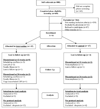Evaluation of the effectiveness and efficacy of Iyengar yoga therapy on chronic low back pain
- PMID: 19701112
- PMCID: PMC4393557
- DOI: 10.1097/BRS.0b013e3181b315cc
Evaluation of the effectiveness and efficacy of Iyengar yoga therapy on chronic low back pain
Abstract
Study design: The effectiveness and efficacy of Iyengar yoga for chronic low back pain (CLBP) were assessed with intention-to-treat and per-protocol analysis. Ninety subjects were randomized to a yoga (n = 43) or control group (n = 47) receiving standard medical care. Participants were followed 6 months after completion of the intervention.
Objective: This study aimed to evaluate Iyengar yoga therapy on chronic low back pain. Yoga subjects were hypothesized to report greater reductions in functional disability, pain intensity, depression, and pain medication usage than controls.
Summary of background data: CLBP is a musculoskeletal disorder with public health and economic impact. Pilot studies of yoga and back pain have reported significant changes in clinically important outcomes.
Methods: Subjects were recruited through self-referral and health professional referrals according to explicit inclusion/exclusion criteria. Yoga subjects participated in 24 weeks of biweekly yoga classes designed for CLBP. Outcomes were assessed at 12 (midway), 24 (immediately after), and 48 weeks (6-month follow-up) after the start of the intervention using the Oswestry Disability Questionnaire, a Visual Analog Scale, the Beck Depression Inventory, and a pain medication-usage questionnaire.
Results: Using intention-to-treat analysis with repeated measures ANOVA (group x time), significantly greater reductions in functional disability and pain intensity were observed in the yoga group when compared to the control group at 24 weeks. A significantly greater proportion of yoga subjects also reported clinical improvements at both 12 and 24 weeks. In addition, depression was significantly lower in yoga subjects. Furthermore, while a reduction in pain medication occurred, this was comparable in both groups. When results were analyzed using per-protocol analysis, improvements were observed for all outcomes in the yoga group, including agreater trend for reduced pain medication usage. Although slightly less than at 24 weeks, the yoga group had statistically significant reductions in functional disability, pain intensity, and depression compared to standard medical care 6-months postintervention.
Conclusion: Yoga improves functional disability, pain intensity, and depression in adults with CLBP. There was also a clinically important trend for the yoga group to reduce their pain medication usage compared to the control group.
Figures







References
-
- Andersson GBJ. Epidemiological features of chronic low-back pain. The Lancet. 1999;354(9178):581–585. - PubMed
-
- Andersson GBJ, Frymoyer JW. The epidemiology of spinal disorders. In: Frymoyer JW, editor. The adult spine: Principles and practice. 2nd ed. Philadelphia, PA: Lippincott-Raven; 1997. pp. 93–141.
-
- Shelerud R. Epidemiology of occupational low back pain. Occup Med. 1998;13(1):1–22. - PubMed
-
- Frymoyer JW, Durett CL. The economics of spinal disorders. In: Frymoyer JW, editor. The adult spine: Principles and practice. 2nd ed. Philadelphia: Lippincott-Raven; 1997. pp. 143–150.
-
- Eisenberg DM, Davis RB, Ettner SL, et al. Trends in alternative medicine use in the United States, 1990–1997: Results of a follow-up national survey. JAMA. 1998;280:1569–1575. - PubMed
Publication types
MeSH terms
Substances
Grants and funding
LinkOut - more resources
Full Text Sources
Research Materials

